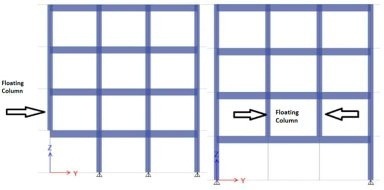Advantages and Disadvantages of Floating Columns | Why Floating Columns are not Advisable
Advantages and Disadvantages of Floating Columns | Floating Column Design
Floating Column
What is Floating Column?
A Floating column is a column that transfers the load from beam to another beam. It is a structural member which rest on a beam, and it does not transfer the load directly to the foundation.
A floating column acts as a point load on the beam, and this beam transmits the load to the columns below it.
The column may start on the first or second or any other intermediate floor while resting on a beam. Typically, the columns rest on the foundation to transfer load from slabs and beams; however, the floating column rests on the beam.
It is designed as a standard compression structural member over the beam or slab, and the beam below the floating column is intended to be load transfer beam, in which beam takes the load of the floating column as a point load.
The beam designed to support the floating column is done with high shear capacity or as deep beams.
The system is so designed that the stub column is not the part of the lateral load resisting system (Earthquake and wind loads). The floating column is analyzed in software by providing pin joints at the ends.
Floating Column Design Details
A Transfer Beam
A transfer beam is a horizontal framework that transmits large gravity loads from above to below structural parts. These are beam elements that are commonly used in the design of high-rise buildings. They are intended to withstand greater loads than a standard beam.
A Transfer Beam & Floating Column
Transfer beams are required at places where column locations are changing, and to transfer the forces from column above to column below.
To design the transfer beams, consider the point loads at the locations where the columns are stopping. This point load will actually to be equal to the magnitude of the column reactions.
Add the other loads which might act on the beam (self-weight, live load acting on the beam). Then check for shear and flexure, similar to a normal beam.
Earthquake and Floating Column
While floating columns should be avoided, they are used in many projects, particularly above the ground floor, where transfer girders are used to create more open space on the ground floor.
In seismic zones, the transfer girders that are used must be carefully planned and detailed. The design and detailing are not difficult provided there are no lateral loads.
Why Floating Columns are not Advisable
The floating column designs can be a dangerous practice used by many structural designers is found undesirable for the following reasons.
They are constructed over the beam, and hence it won’t be having any form of continuity with the structural elements below it.
A floating column forms one of the essential main structural members of a structure but can attract large seismic forces in seismic prone regions or during earthquakes.
A floating column can make every floor different, with the other grid system and will affect vertical symmetry of the building. The structure will have poor performance when subjected to earthquake forces.
Using floating columns in buildings increases the storey displacement and storey drift under the action of lateral force.
With a floating column base shear created at the building support during earthquake activity is high.
This floating column tends to increase the base shear and story displacement of buildings under earthquake action, and it is not a desirable performance. Therefore, past performance of the floating column in seismic prone regions make them unsuitable in future construction. They are limited to support gravity loads alone.
Advantages and Disadvantages of Floating Columns
Advantages of Floating Columns
- A Floating column is primarily used to fulfil the architectural requirements of a building. Floating columns are significant when the lower floor has a large span hall having rooms on its upper floor like hotel or auditorium
- Floating columns are useful in the construction of soft storeys.
- The plan layout on every floor can be different
- The rooms can be partitioned, and some portion can be raised without raising the whole area.
Disadvantages of Floating Column
- · The primary disadvantage of floating columns is that it often suffers during the earthquake and when subjected to major seismic movements. Beams supported by floating columns may experience a large amount of bending, shear forces and tension forces. However, this problem can be reduced but still not advisable in case of lateral loading.
- · Floating columns attracts extensive forces.
- · Floating columns increases storey displacement in structures.
- · Because the floating columns do not rest on primary continuous columns, discontinuity happens with the below and above columns, making it vulnerable.
